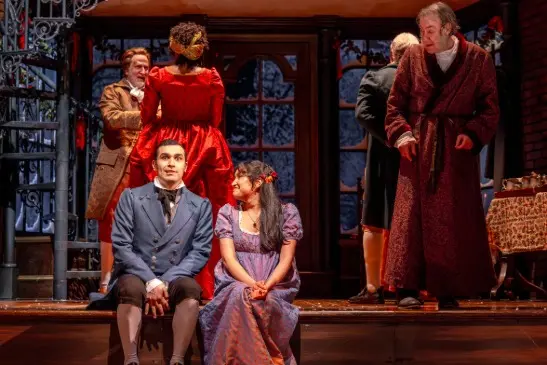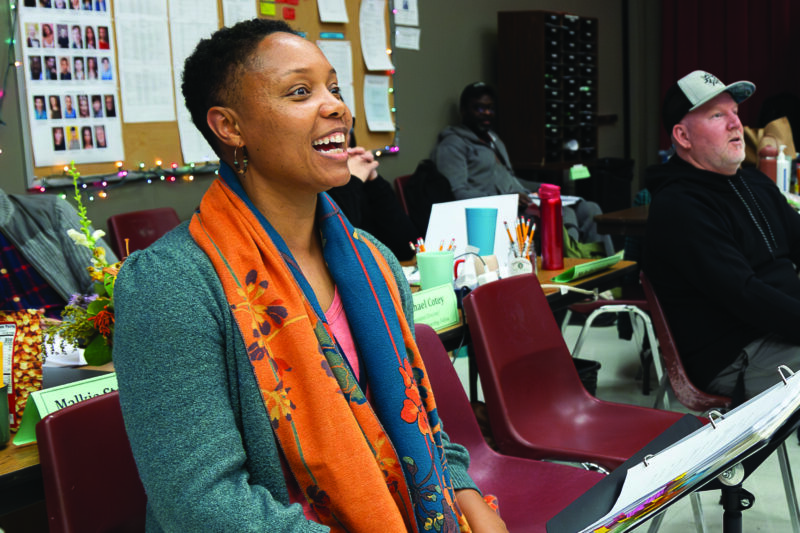A Christmas Carol begins November 15.
By Anna Rogelio Joaquin
Costume Shop Manager Heidi McMath has been with The Goodman for nearly four decades, more than two of which she’s helped bring A Christmas Carol to life—not through words or music, but through fabric, color and imagination. This season, she sat down with School Programs Manager Anna Rogelio Joaquin to discuss the art and evolution of costuming this beloved tradition.
Anna: What are some ways costumes help tell the story and what do they communicate?
Heidi: In the case of A Christmas Carol, it’s a period show set in 1843, which is when the book was written. Most of our costumes are based on research of what people wore in 1843 or thereabout. Some of the show is a flashback to Scrooge as a young boy, so that’s 30 years earlier. It’s based on photographs, paintings, drawings—anything we can find that helps us understand what people wore and what each class of people wore. And there is a lot of research to be found for different occupations too.
Anna: What kinds of jobs do you represent through the costumes?
Heidi: One of my favorite characters has always been the poulterer. The poulterer is a character who has his own shop, so that means he has a little bit more station in life, a little bit more money, but he does still take out his wares and sell them on the streets. I had a sketch of men from the period, from a book on laborers in 19th-century London, and every one of them is in what we would call a frock suit: a jacket, vest, shirt, pants, boots, a big apron over it and big sleeve guards over it. We wouldn’t walk into doing that kind of work and wear anything but washable things. The world of clothing was a little bit more formal in those days than what we do in our sweats and our yoga pants and so forth.
Also, the way things worked in those days is people brought their farm wares up into the city from the farm on market days, much like when we have market day in the Loop here. One of my favorite characters has a straw hat that, in the day, anybody would have seen and known that person was from the country. One of the things that identified country people when they came into the city is they often wore these long smocks that were somewhat embroidered and sometimes fanciful, but usually was their workday clothing.
Anna: What’s the process of creating a new costume for the show like?
Heidi: A lot of times, what will happen is some of the clothes that were on wealthier characters get distressed down and get worn by more of the lower class characters, which was actually pretty typical, because in those days, you couldn’t just go and buy ready-made, inexpensive clothing. What people tended to do was either they made their own, if they had the skill, or they would go to rag shops, like we would go to a used clothing store.
Anna: Can you share more about the costume team who helps make this magic happen?
Heidi: There are design assistants, who are the heads of what I call the procurement team. They pull from old shows to manage the size of this show on the budget we have. They also do most of the communication between stage management, the designer and the shop. They are the ones tracking changes and making dressing sheets for every actor. Wardrobe uses those to document every change and train covers.
The rest of the costume shop is in our building. We have a craftsperson who handles millinery, dyeing, jewelry and belts; someone who manages hair and wigs; two in-house drapers who make patterns and fittings; and a first hand assistant who helps construct the garments. It’s a big, collaborative effort—and it’s what keeps A Christmas Carol looking fresh year after year.
This article is adapted from a study guide created by The Goodman’s Education and Engagement Department for the Student Matinee Series. To view the full study guide, click here.




